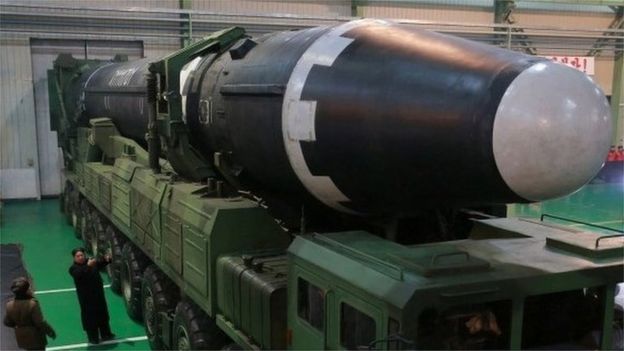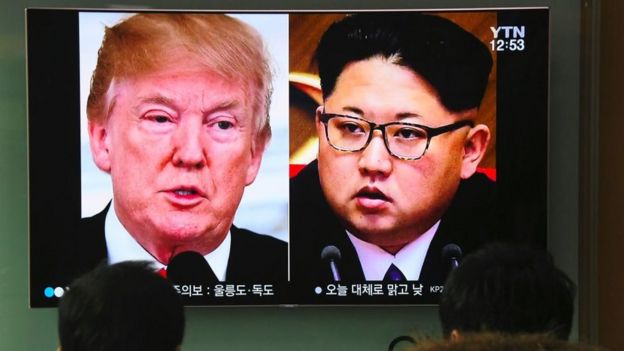.
Why has Kim Jong-un halted North Korean tests now?
Kim Jong-un's announcement that North Korea is to halt nuclear and missile tests immediately comes as he prepares for two major diplomatic events. Analyst Ankit Panda asks what the North Korean leader hopes to gain with his latest move.
North Korea's declaration will no doubt lead to effusive headlines touting an end to nuclear and long-range missile testing, but a look at the country's historical record and the context of its nuclear and missiles programme suggests that we might temper our expectations.
First, regarding nuclear testing, the statement released on Saturday makes clear that the reason Kim Jong-un is submitting voluntarily to a testing freeze and to the closing of the Punggye-ri nuclear testing site - the scene of all six of North Korea's nuclear tests since 2006 - is because he feels that his country has mastered the design of nuclear weapons.
Although difficult to verify, this claim is not obviously an exaggeration or unbelievable.
Consider that India and Pakistan, by 1998, had each conducted six nuclear tests and are now counted among the pantheon of nuclear weapons possessors, without conducting further tests.
North Korea, with an additional eight years of access to knowledge available in open source material concerning nuclear weapons design, can feel similarly comfortable with its six nuclear tests.
- North Korea crisis in 300 words
- North Korea's nuclear programme explained
- Did sanctions push N Korea into US talks?
'City-busting yields'
On a more granular level, North Korea's fifth and sixth nuclear tests - in September 2016 and 2017 respectively - marked important benchmarks. The September 2016 test, according to North Korean state media, involved a standardized and compact nuclear device, one that could be mounted on any of its various short, medium, intermediate, and intercontinental-range missiles (ICBMs).
 KCNA VIA REUTERS
KCNA VIA REUTERSThe expected yield - or explosive power - of those weapons might be of the order of two-to-three times the weapon that the United States used against Nagasaki in the final days of the World War Two - but that's quite powerful enough for North Korea's purposes.
More seriously, North Korea's most recent nuclear test demonstrated that it had the capability to generate seriously powerful nuclear yields.
While independent experts and various national intelligence agencies haven't reached a consensus on whether North Korea had truly mastered a thermonuclear bomb design, as it claimed to have done, the seismic data recorded on 3 September 2017 gave the world enough information to conclude that North Korea had a nuclear device capable of "city-busting" explosive yields.
The bottom line is that just as Kim Jong-un's recent trip to Beijing was a show of strength - a signal that he felt comfortable enough in his consolidated domestic power to leave North Korea - so too is the declaration of a nuclear test ban a sign that he feels renewed confidence.
Limited costs to halting missile tests
Regarding his missiles, Kim has said that he will no longer test ICBMs.
On the one hand, that's surprising.
North Korea has conducted just three tests in total of missiles that could deliver nuclear weapons to the contiguous United States. None of these tests have involved a missile flying on a trajectory similar to what might be necessary for a nuclear strike, leaving further flight-testing something of a necessity for North Korea to become sufficiently confident in its ability to strike the US homeland.
But North Korea may have other plans. For instance, while it has mastered most of what is necessary on a technical level to threaten the United States, its missile forces continue to be limited by a small number of launchers. Currently, North Korea has probably only six launch vehicles for its ICBMs.
Even though Kim Jong-un, during his 2018 New Year's address, declared his nuclear forces "complete," there is good reason to believe that he would want to increase his ICBM launchers and even work on components of North Korea's nuclear command and control systems.
 REUTERS
REUTERSTactically, then, submitting to a self-imposed ICBM flight-testing ban would have limited costs.
Easy to break ban
Ultimately, these test bans are restricted in their extent.
The nuclear test ban could be made credible by a bona fide gesture at the Punggye-ri nuclear test site. North Korea, for instance, could demolish its test tunnels; the statement released on Saturday notes only that the site will be "dismantled".
But as long as North Korea hangs on to its missiles, it can break its self-imposed ban with little warning. In 1999, North Korea submitted to a missile testing moratorium, but that eventually broke down in 2006, a few years after the collapse of the 1994 Agreed Framework.
Beyond the bans, Mr Kim used the latest Central Committee meeting to tout the success of his fundamental national strategic project, which is summarized in what he has called the byungjin line. This concept refers to the simultaneous development of a powerful state nuclear force alongside a more prosperous economy.
On Saturday, Kim Jng-un clearly indicated that with the cessation of nuclear testing, he will "concentrate all the efforts on building a powerful socialist economy and markedly improving the standard of people's living."
That should be taken seriously. North Korea will seek relief from international sanctions at the forthcoming summits to realise this objective.
The summit is the prize
The concessions from North Korea have come before the two anticipated summits with the United States and South Korea.
 GETTY IMAGES
GETTY IMAGESOne may wonder why Mr Kim should give up so much in advance instead of hanging on to a nuclear test-ban and an ICBM moratorium as aces up his sleeve to give up when he meets US President Donald Trump.
The answer is simple: a summit with a US president is enough of a prize in itself. For Mr Kim, it's something that neither his grandfather nor his father could attain.
In the end, what North Korea loses by demolishing its nuclear test site and submitting to a unilateral moratorium on ICBM launches is entirely tolerable compared to what Mr Kim gains by sitting alongside President Trump.
Reading KCNA's announcements on Saturday, there is also absolutely no hint of the "denuclearization" intent that South Korean officials have been eager to tout on North Korea's behalf.
On the contrary, North Korea's announcement sounds like the declamations of a nuclear weapons state - one that has no intention of giving up those weapons which give the country its ultimate guarantee of survival.
Even though President Trump has lauded Mr Kim's move as "big progress," the sooner he recognises Kim's ultimate objectives, the better.
Ankit Panda is an adjunct senior fellow at the Federation of American Scientists and a senior editor at The Diplomat.
'한국정치 > 북한_DPRK' 카테고리의 다른 글
| Summit trivia 김정은 경호 12인 (0) | 2018.04.29 |
|---|---|
| 햇볕 정책 Sunshine 용어 (0) | 2018.04.29 |
| 2007 년 노무현 김정일 회담과 2018년 문재인 김정은 회담 차이점 (0) | 2018.04.29 |
| Korean summit sparks cold noodle craze 평양 냉면 열풍 Raengmyun (0) | 2018.04.29 |
| North Korea nuclear test site to close in May, South Korea says (0) | 2018.04.29 |
| bbc :Koreas summit: Five key moments from the Kim-Moon meeting (0) | 2018.04.29 |
| 초,중,고등학교 학생들 시청 소감, 평화 군축 통일 교육 - 김정은 문재인 정상회담 시청 (0) | 2018.04.28 |




